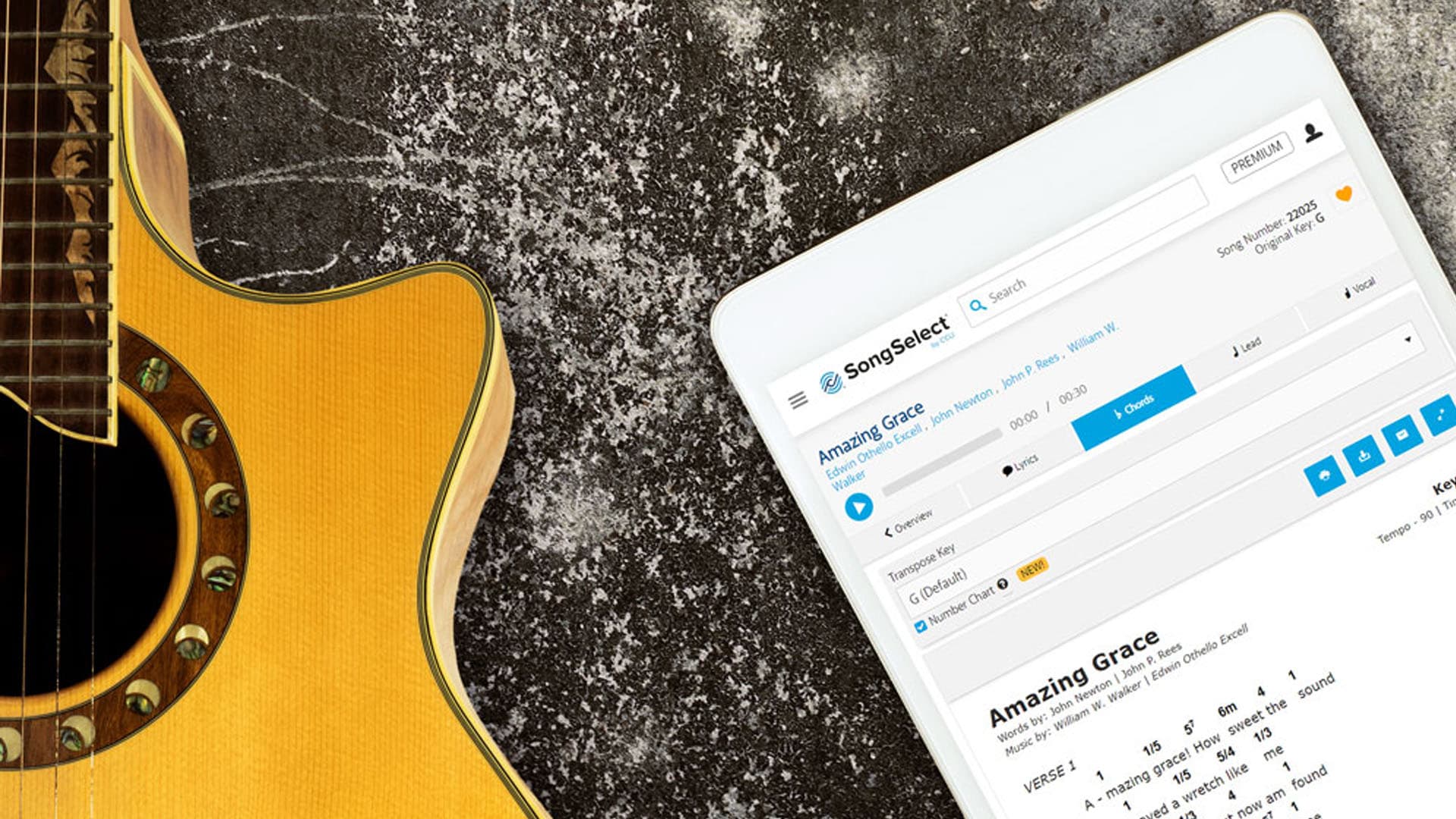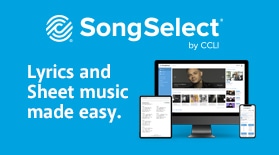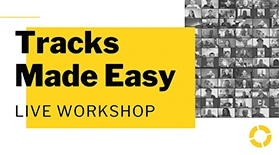CCLI Topics
SongSelect’s New Number Format: We Heard You

Editor’s Note: The Nashville Number System is a simplified system developed by Neal Matthews in the late 1950’s, using numbers instead of Roman numerals from standard music theory. We adopted some of the principles from the Nashville Number System to provide our own number format in SongSelect. The numbers option may be accessed directly in SongSelect and is not available through any third-party software. Simply go to your desired chord sheet within SongSelect (see the “Amazing Grace” example in the photo above) and click the “Number Chart” option.
Here at CCLI, we are always looking for ways to serve you better, and the best way to begin is by listening. I’m a member of a couple different Worship Leader groups on Facebook, and CCLI topics come up from time to time. I’ve found that it’s a great way to get real-world, unfiltered feedback about our licenses and services.
When a couple recent discussions showed a clear desire for us to add the Number System as an option on our SongSelect chord sheets, I raised the possibility with our web development and project management teams. It didn’t take long to determine that we could use our existing logic and technology for key transposition, since it’s all based on the same chord intervals. Thinking of numbers as simply a different “key,” the process was fairly easy.
A Quick Explanation
For musicians who may be unfamiliar with the Number System, here’s a quick explanation and a couple examples. First, pick a key—any key. (No, it’s not a magic trick.) If you choose the key of A, then the A chord will be the 1 chord.
From there, we start counting, according to the scale. The next two most common chords in the key of A are the D chord and the E chord. Counting up from A, the D chord is the 4, and the E chord is the 5. So when you hear musicians talk about a 1-4-5 progression, that’s what they’re talking about.
Now let’s change keys. Let’s say that A is too low for your vocalist, and they’re more comfortable in C. So C becomes the 1 chord. Counting up the scale, your 4 chord is F and your 5 chord is G.
Without getting too deep into the theory of it all (yet staying within the diatonic “Do-Re-Mi” scale) the 1, 4, and 5 chords will be major, the 2, 3 and 6 chords will be minor and the 7 chord will be diminished.
Here’s your cheat sheet for the 2 keys we just mentioned.
| 1 A C | 2m Bm Dm | 3m C#m Em | 4 D F | 5 E G | 6m F#m Am | 7dim G#dim Bdim |
Here’s another cheat sheet for a couple more common keys for worship songs.
| 1 D G | 2m Em Am | 3m F#m Bm | 4 G C | 5 A D | 6m Bm Em | 7dim C#dim F#dim |
If this is a bit of a brain-twister for you, just relax. Like any new language, it takes time and practice. But as you become accustomed to the number concept, the relationship of the chords to each other in the progression will begin to make more sense. You’ll find that you’ll have better anticipation musically, and you’ll begin to think in numbers, because the intervals are constant, no matter what key you’re in. You’ll start “hearing” the 4 chord and the 5 chord (and all the other chords) in any song, because each has its own “sound.” Eventually, your team will start communicating in progressions. “1-5-6-4.” “6-3-5-4.” “2-5-1.” And so on.
Strictly speaking, in the Nashville Number System, a stand-alone number means a major chord. And here’s where typical musician conversations can cause confusion. When musicians talk about 6’s, 2’s and 3’s, we’re usually implying minor chords, since that’s what we use 99% of the time. But yes, there are exceptions. For example, if you’re in the key of C, and you see a stand-alone “2” on the chart, you need to play a D major chord. It doesn’t happen often, but it’s something to be aware of.
For songs in minor keys, musicians have adopted one of several different number systems. As of Sep 2019, SongSelect uses the relative major key to derive numbers as prescribed by Chas Williams in his book The Nashville Number System. For example, C is the relative major key for Am. These two keys share the same key signature. As explained above, in the key of C major the chord “Am” displays as “6m”. So, if we have a song in the key of Am, SongSelect uses the relative major key of C to derive the number: the chord “Am” then displays as “6m”, the chord “C” displays as “1”, and so on.
How We Did It
As mentioned, it was fairly simple to employ the same logic we use for our key transpose function, but we also wanted to present it well. Gary Lowry, one of our SongSelect engravers and the lead designer on this project said, “Since I grew up in Franklin, TN, and played in many recording sessions using Nashville Number System charts, I’ve seen them in all shapes and sizes. We realize that true NNS charts don’t include lyrics, plus they provide many shorthand symbols that won’t translate into our SongSelect chord sheets. But we were able to adopt the principles of replacing chord letters with numbers, so chord progressions remain the same, no matter what key you’re in. Our new SongSelect Number Format truly combines the best of both worlds. I wanted to make them pickers and session musicians proud!”
Chris Birch, our Software Development Manager, added, “It felt really rewarding to see so many positive responses. As a CCLI developer, it is a great feeling to know that what we do makes life simpler and better for worship leaders and songwriters.”
Reactions
Here are just a few of the many enthusiastic reactions that Chris mentioned, once the worship leaders on social media discovered the new feature.
“This is a game changer! It’s helping our team so much. It’s taking their playing to a new level. Thank you!!” -Jessica Martin
“This is so incredible! My team celebrated so hard when I sent them screenshots!” -Jeremy Stavropoulous
“Can’t wait to use this with my team.” -Ben Renfro
“My worship team was ecstatic when I told them.” -Bea Anna
“It would help increase musicality of church musicians if more people learned to play like this.” -Andy Baker, Homegrown Worship
Thanks everyone, for the great responses. We’re glad to know this is working so well for so many of you.
Go to SongSelect >





